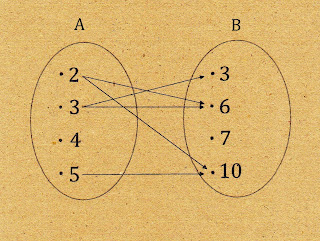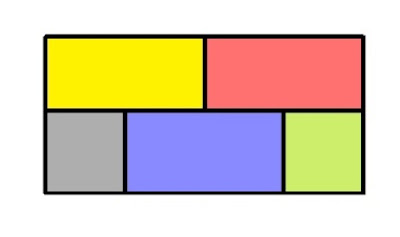RELATIONS AND FUNCTIONS
Cartesian products of sets
If you have two sets A and B. The cartesian product A Ⅹ B = { (a, b ) : a ∈ A, b ∈ B }
If you have two sets A and B. The cartesian product A Ⅹ B = { (a, b ) : a ∈ A, b ∈ B }
- Example: Let A = { a, b } and B = { 5, 7, 9 }, then A Ⅹ B = { (a, 5 ), (a, 7 ), ( a, 9 ), ( b, 5 ), ( b, 7 ), ( b, 9 ) }.
- B Ⅹ A = { ( 5, a ), ( 5, b ), ( 7, a ), ( 7, b ), ( 9, a ), ( 9, b ) }.
- If either A or B is a null set, then A Ⅹ B will also be empty set, i.e. A Ⅹ B = Φ.
- Two ordered pairs are equal, if and only if the corresponding first elements are equal and the second elements are also equal. Let two ordered pairs ( a, b ) and ( c, d ) be equal, i.e., ( a, b ) = ( c, d ), if and only if a = c and b = d.
- If there are x elements in A and y element in B, then there are xy elements in A Ⅹ B, i.e., if n(A) = x and n(B) = y, then n(A Ⅹ B) = xy.
- If A and B are non-empty sets and either A or B is an infinite set, then A Ⅹ B would also be infinite.

- A Ⅹ B Ⅹ C = ( A Ⅹ B ) Ⅹ C = A Ⅹ ( B Ⅹ C ).
Relations
A relation R from a non-empty set A to a non-empty set B is a subset of the cartesian product A Х B. The subset is derived by describing a relationship between the first element and the second element of the ordered pairs in A Х B.
We find that 2 divides 6 and 10, 3 divides 3 and 6, 5 divides 10 and there is no number in B that can be divided by 4.
Thus ( 2, 6 ) ∈ R, ( 2, 10 ) ∈ R, ( 3, 3 ) ∈ R, ( 3, 6 ) ∈ R, and ( 5, 10 ) ∈ R.
A relation R from a non-empty set A to a non-empty set B is a subset of the cartesian product A Х B. The subset is derived by describing a relationship between the first element and the second element of the ordered pairs in A Х B.
- The second element is called the image of the first element.
- The set of all first elements of the ordered pairs in a relation R from a set A to a set B is called the domain of the relation R.
- The set of all second elements in a relation R from a set A to a set B is called the range of the relation R.
- The whole set B is called the codomain of the relation R.
- Range ⊆ codomain.
- Let A = { 2, 3, 4, 5 } and B = { 3, 6, 7, 10 }. A relation R from set A to the set B as follows: R = { ( x, y ) : x divides y, where x ∈ A and y ∈ B }.

We find that 2 divides 6 and 10, 3 divides 3 and 6, 5 divides 10 and there is no number in B that can be divided by 4.
Thus ( 2, 6 ) ∈ R, ( 2, 10 ) ∈ R, ( 3, 3 ) ∈ R, ( 3, 6 ) ∈ R, and ( 5, 10 ) ∈ R.
Therefore R = { ( 2, 6 ), ( 2, 10 ), ( 3, 3 ), ( 3, 6 ), ( 5, 10 ) }.
- Domain of R = { 2, 3, 5 }
- Range of R = { 3, 6, 10 }
- Codomain of R = { 3, 6, 7, 10 }
- Also R-1 = { ( 6, 2 ), ( 10, 2 ), ( 3, 3 ), ( 6, 3 ), ( 10, 5 ) }.
A relation may be represented algebraically either by the Roster method or by the Set-builder method.
An arrow diagram is a visual representation of a relation.
An arrow diagram is a visual representation of a relation.
- The total number of relations that can be defined from a set A to a set B is the number of possible subsets of A Х B. If n(A) = p and n(B) = q, then n(A Х B) = pq and the total number of relations is 2pq.
Let A and B be two sets and R be a relation from the set A to the set B. Then the inverse of R, denoted by R-1 is a relation from the set B to the set A and is defined by
- R-1 = { ( b, a ) : ( a, b ) ∈ R }
- Dmoain of R = Range of R-1
- Range of R = Domain of R-1
Function
Function is a special type of relation. It is one of the most important concepts in mathematics.The word function is derived from a Latin word meaning operation and the word mapping and map are synonimous to it. Functions play very important role in Calculus.
 Example
Example
Function is a special type of relation. It is one of the most important concepts in mathematics.The word function is derived from a Latin word meaning operation and the word mapping and map are synonimous to it. Functions play very important role in Calculus.
- A relation f from a set A to a set B is said to be a function if every element of set A has one and only one image in set B.
- In other words, a function f is a relation from a non-empty set A to a non-empty set B such that the domain of f is A and no two distinct ordered pairs in f have the same first element.

- The function f from A to B is denoted by f : A ⟶ B.
- A function which has either R ( real numbers ) or one of its subsets as its range is called a real valued function.
- Further, if its domain is also either R ( real numbers ) or subset of R, it is called real function.
 Example
Example- Let A = { -2, -1, 0, 1, 2 } and B = { 0, 1, 2, 3, 4, 5, 6 }
- f be a function, f : A ⟶ B given by f ( x ) = x2
then f ( -2 ) = 4, f ( -1 ) = 1, f ( 0 ) = 0, f ( 1 ) = 1, f ( 2 ) = 4. - Here domain ( f ) = { -2, -1, 0, 1, 2 } = A and range ( f ) = { 0, 1, 4 }.
- Identity function
- constant function
- Polynomial function
- Rational function
- Modulus function
- Signum function
- Greatest integer function
- Addition of two real valued functions: Let f : X ⟶ R and g : X ⟶ R be any two real functions where X ⊂ R. Then we define ( f + g) : X ⟶ R by ( f + g ) ( x ) = f ( x )
+ g ( x ), for all x ∈ X. - Subtraction of two real valued functions: Let f : X ⟶ R and g : X ⟶ R be any two real functions where X ⊂ R. Then we define ( f - g ) : X ⟶ R by ( f - g ) ( x ) = f ( x ) - g ( x ), for all x ∈ X.
- Multiplication by a scalar: Let f : X ⟶ R be a real valued function and α f is a function from X to R defined by ( α f ) ( x ) = α f ( x ), x ∈ X.
- Multiplication of two real functions: The product of two real functions f : X ⟶ R and g : X ⟶ R is a function f g : X ⟶ R defined by ( f g ) ( x ) = f ( x ) g ( x ), for all x ∈ X. This is also called pointwise multiplication.
- Quotient of two real functions: Let f and g be two real functions defined from X ⟶ R where X ⊂ R. The quotient of f by g denoted by f / g is a function defined by ( f / g ) ( x ) = f ( x ) / g ( x ), provided g ( x ) ≠ 0, x ∈ X.



Comments
Post a Comment